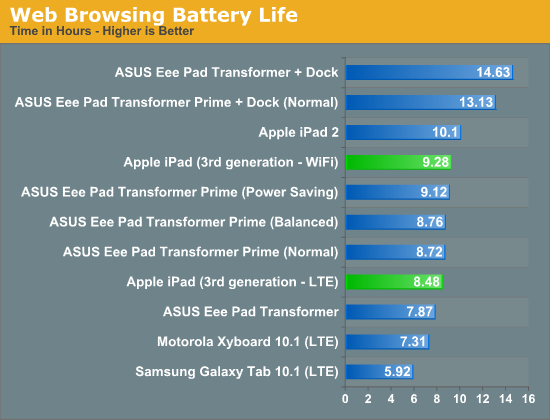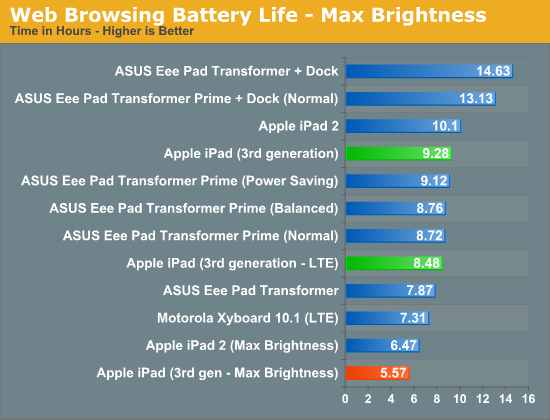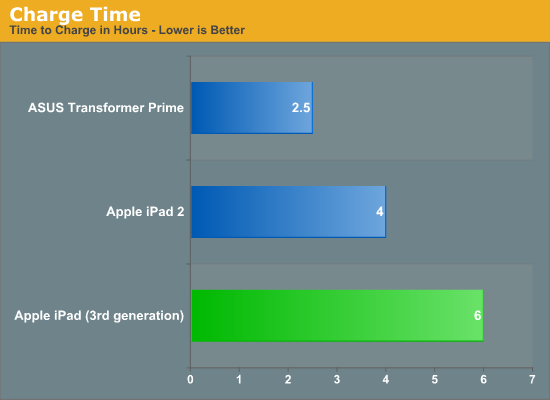The Apple iPad Review (2012)
by Vivek Gowri & Anand Lal Shimpi on March 28, 2012 3:14 PM ESTBattery Life
For a company that has been so laser focused on reducing weight and device thickness, the new iPad actually growing in both of these dimensions was unexpected. From a technical standpoint, the tradeoff makes sense. The new Retina Display consumes significantly more power than its predecessor, as do the A5X and MDM9600 baseband. Both of those ASICs are still built on a 4x-nm LP process and will surely increase power consumption over the iPad 2.
With more transistors switching on the same process node and a display (and backlight) driving more pixels at the same brightness, the battery either had to be larger or battery life would suffer. Apple understandably chose the former and the new iPad ships with a 42.5Wh battery—the largest we've ever seen used in an ARM tablet. The new iPad's battery is so large it's even bigger than what Apple uses in the 11-inch MacBook Air, and it's within striking distance of the 50Wh unit you'll find in the 13-inch model. I do believe this move says a lot about how Apple sees the iPad moving up in the world, but I'll get to a discussion about that later.
With a 70% larger battery than the iPad 2 but with more power hungry components inside, how does the new iPad fare in real world usage? Subjectively: it doesn't last as long as its predecessor. Objectively, our numbers seem to agree.
Our web browsing battery life test browses through dozens of web pages, pausing on each to simulate reading time, until the battery is depleted. All of our tests are run at the same brightness settings (200 nits) to ensure we are comparing apples to apples.

On WiFi we measured an 8% decrease in battery life compared to the iPad 2—nothing huge but not insignificant either. Fall off of WiFi and depend on LTE and you'll see around a 9% decrease in battery life, again—noticeable but not unusable.
I also threw in numbers from the Motorola Xyboard 10.1, an LTE enabled Android tablet running 3.2. Equipped with a much smaller battery (~26Wh), the Xyboard 10.1 delivered 7.31 hours in our LTE web browsing test. The new iPad managed to last 16% longer on a single charge—a smaller advantage than you'd expect given the 70% increase in battery capacity, showing just how much power the new Retina Display and its backlight consume.
The iPad is more than usable on long flights or throughout the day without being tethered to a wall outlet, but in practice you can expect a decrease in battery life compared to last year's model.
Keep in mind that these values are all at 200 nits (roughly 70% brightness on the iPad). If you use the iPad at max brightness (~400 nits) you'll see considerably lower numbers:

In our web browsing test, at max brightness, we saw 5 hours and 34 minutes of continuous use before the battery died. The iPad 2 incurs a similar penalty, lasting under 7 hours in the same test. Do keep this in mind if you need to get a lot of untethered use out of the new iPad. In order to come close to Apple's battery life estimates you'll have to be below 70% brightness.
Charging
Despite the significant increase in battery capacity, Apple continues to ship the new iPad with the same 10W USB power adapter as the previous two models. You can charge the iPad via a Mac/PC USB port that implements the USB charging spec, however doing so will take a minor eternity to fully charge the tablet. Just as before, the new iPad will not charge off of a USB port if the tablet is awake; it will only charge when locked/asleep. The convenience of having a USB based charger is evident, but you'll want to stick with the 10W adapter to actually charge the iPad.
Charging the larger battery does take longer. If we measure from a completely dead state to when the iPad indicates that it's fully charged the increase in time is approximately 50%, from 4 hours with the iPad 2 to 6 hours with the new iPad. ASUS' Transformer Prime, by comparison, requires only 2.5 hours as it ships with an 18W charger. And no, you can't use ASUS' charger to speed up charge times on the new iPad—when connected, the TF Prime charger will only supply 9W to the iPad.

The story doesn't end there however. While the iPad 2 will draw 0W after its 4 hour charge cycle is complete, the new iPad will continue to draw around 3W after it claims to be fully charged. This will continue for roughly another hour at which point the power adapter will draw anywhere from 0.1—0.6W.
Note that when running at full brightness and with a heavy GPU load (e.g. Infinity Blade 2), the power adapter can't supply enough to keep the iPad charged and drive the display/internal components.
There's no good solution here other than for Apple to start shipping the iPad with a higher wattage power adapter. I do believe faster charge times are going to be necessary if Apple is keen on sticking with this larger battery, not to mention the usage issues of not being able to maintain charge equilibrium under load.
Thermals
The increase in power consumption of the new iPad also manifests in the form of increased heat production. A 163mm^2 SoC built on a 45nm LP process is a serious chip. Although it doesn't run hot enough to require active cooling, the SoC alone is responsible for a couple of watts of the iPad's TDP under heavy load. Combine that with a 45nm LTE modem and the heat put off by the more powerful backlight and you've got a recipe for a noticeably warmer device.
Does the new iPad get warmer than the previous one? Absolutely. I would even go as far as to say that it can get uncomfortably warm, but it never gets too hot to hold. If you've used any of the modern Mac notebooks, I don't believe it's anywhere near as bad.
When holding the new iPad in portrait mode, with the home button at the bottom, the lower left corner of the device ends up being the warmest. Along the left edge of the iPad is where the logic board resides, and the lower half is home to the A5X SoC. Under load, particularly a heavy GPU load (e.g. playing a 3D game), this area is going to heat up quickly.
I took several measurements using a contactless IR thermometer in the same ambient conditions on a new iPad vs. the iPad 2. The results are below:
| Thermal Comparison (Max Temperature) | |||||
| iPad 2 | iPad (3rd generation) | ||||
| Web Browsing (2 hours) | 32.7˚C | 37.6˚C | |||
| Infinity Blade 2 (1 hour) | 34.2˚C | 41.9˚C | |||
Again, I don't believe this is a deal breaker but it's the obvious result of remaining on Samsung's 45nm LP process combined with a more power hungry display/backlight. I suspect there will be improvements in efficiency on the display side over time, but I can't see the Retina Display being any lower power than the iPad 2's 1024 x 768 screen. The real avenue for improvement will be when Apple shifts to 28/32nm silicon for the SoC and LTE modem. If you want a cooler running iPad, you'll have to wait until next year for that.










234 Comments
View All Comments
PeteH - Tuesday, April 3, 2012 - link
I have to be honest, after reading through that link I didn't see anything that even implied working conditions had anything to do with the suicides of the factory workers. The only suicide for which there was any real information provided was that of the worker who killed himself after losing the iPhone prototype, and in that case the victim wasn't a factory worker, but someone in logistics.Did working conditions have anything to do with the factory worker suicides? Maybe, maybe not. There doesn't appear to be evidence either way.
mr_ripley - Wednesday, April 4, 2012 - link
I posted the Wikipedia link for all the links in the reference section.Here's a more direct report: http://sacom.hk/wp-content/uploads/2010/11/report-...
And a companion video: http://vimeo.com/17558439
The video includes an interview of a survivor who is now paralyzed waist down.
You can choose to patiently read and watch this report or just turn a blind eye like a lot of people do.
PeteH - Thursday, April 5, 2012 - link
I did read the report. It details unbelievably miserable working conditions in the factories, which I don't think anyone is disputing, and concludes that the way to change those conditions is to pressure the electronics companies making the bulk of the profits. None of the above comments dispute any of this. However it does not link working conditions to suicides among factory workers.And yet you continue to insist that there is a link, with no evidence to back it up. You make statements like, "over a hundred of them have committed suicide over the working conditions," "...scores of people killing themselves citing poor working conditions," and "there is no disputing the fact that these deaths are related to working conditions," but you provide only conjecture to back it up, no proof. When you do this people start dismissing everything you say out of hand, even the things that are accurate. And worse than that, you run the risk that other people arguing for better working conditions will be tarred with the same brush. Look at what happened to Mike Daisy.
Again, I'm not saying working conditions didn't contribute to the suicides, I'm saying there is no evidence one way or the other. Until you have evidence (in the form of suicide notes, higher suicide rates among factory workers, etc.) please stop. You may actually be hurting the very movement you're trying to help.
mr_ripley - Thursday, April 5, 2012 - link
Well, I'm sorry if it is inconvenient for you that these individuals have not said it in so many words. Should we expect them to?... Hey, by the way, I know you're going to kill yourself but why don't your write down an explanation first so we can conclusivly say what the reasons are. And even though you are under a lot of stress right now and are clearly not thinking straight SPELL it our for me please...Evidence can come in different forms. Not all of it is directly incriminating, in which case the attention turns to the circumstances. So if these reports don't establish a reasonbly clear coorelation to you, then I am sorry but I disagree.
You can nitpick on specific words in my comments and quible about words such as evidence. But what are you accomplishing here? Are you justifying your own guilt of purchasing a device manufactured here? Are you an Apple or Foxconn mouthpeice? Do they pay your for spreading lies like Foxconn factories are actually a good place to work (which has been said in the previous comments)? Really, it is people like you need to STOP.
I'm not going to stop saying what I believe is right!! And unlike Mike Daisy I have not fabricated any evidence. At the most, you can complain that I have drawn incorrect conclusions and I am saying the same about you.
PeteH - Thursday, April 5, 2012 - link
It's inconvenient for me that you are lying. You're the one saying that there are, "...scores of people killing themselves citing poor working conditions," not me. Either show me a case where those people who killed themselves cited poor working conditions as the reason, or cease claiming it is fact. You do damage to the movement that's trying to improve things.People hear the news reports about Mike Daisy lying to Ira Glass and what they take away is not the specific lies (claiming to witness things had actually happened but that he had only read about), it's that he's a liar and the story wasn't true. They dismiss the whole issue of poor working conditions out of hand. That's what you risk when you lie to get people to listen.
mr_ripley - Thursday, April 5, 2012 - link
Go ahead, nitpick on specific phrases and completely lose the meaning. But the problem is easily corrected. One can argue that citing something does not have to be done on paper as you would in a professional article. To me the workers "cite" the existence of a problem through their actions as words have failed them.Still if you want me to rephrase I'll say "scores of people killing themselves in midst of poor working conditions.." Can you prove that this statement is inaccurate??
And while you ask me for evidence have you ever bothered to see if you can find evidence that these deaths are not related to working conditions. Prove it to me and I'll take back everything I said.
PeteH - Thursday, April 5, 2012 - link
I think you missed the places above where I stated, "I'm not saying working conditions didn't contribute to the suicides, I'm saying there is no evidence one way or the other." That was my whole point. And I did explicitly state that there's no disputing the poor working conditions. So no, I have no problem with your revised statement.However, I don't think what I did was nitpicking at all. Nitpicking would be pointing out that a score is 20, so scores would imply at least 40, and I've only seen documentation of 17 suicides (I haven't seen numbers pre-2010). But that's not what I did.
shompa - Friday, March 30, 2012 - link
Manufacturing employees?Look at the world! There are about 20 countries in the world that are democratic and have great living standards. Its just 100 years ago since these countries had child workers and harsh condition.
BTW. My county is on the "top countries" in the world. Still we have the largest suicide rate in our population in the world. Why are you not fighting against the Swedish government that drives thousands to kill them self each year? We live like slaves here with 80% taxes.
BTW. Do you care if other companies use HonHai/FoxConn or is it just Apple? Are you writing the same thing about Dell/HP and all other companies that use FoxConn?
What have you done?
Have you donated money to a chinese worker? Or is Trolling the only thing you manage to do?
grave00 - Friday, March 30, 2012 - link
I was curious about this statement. Could you elaborate. What inconsistency is there?"On the iPhone Apple has been entirely too lax about maintaining consistency between suppliers. If it wants to be taken seriously in this space Apple needs to ensure a consistent experience across all of its component vendors."
loboracing - Friday, March 30, 2012 - link
I remember an ad that touted something new to "see and touch". The retina screen is the "see" part but what about the "touch"? Was that just a gimmick meaning you could touch the screen, or is there some sort of different feel to the screen?